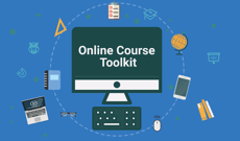After the COVID-19 pandemic forced countless people to stay home to flatten the curve, we’re seeing a rise and demand for online learning.
Whether these courses are certificate courses from Ivy League schools like Harvard or Yale, online courses on Udemy, or online workshops hosted by entrepreneurs scaling their businesses, we can only expect online courses to increase in popularity as time goes on.
So if you’re planning to launch an online course in 2020 or want to upgrade your existing courses, we’re showing you how to do it in this blog post. Keep reading to see how to create your first workbooks to empower your online learning efforts.
Why Create Workbooks to Accompany Course Content
Not all online courses are created equal. In this section, we’ll show you how beautifully-designed workbooks can make your online courses even more compelling and efficient.
They increase your course value
First and foremost, adding workbooks for online course students is a fantastic way to increase both the perceived and actual value of your course.
For current students, you’re able to help them see the ROI of your course lessons with a well-crafted workbook to supplement their learning. And for potential customers, you can help convert them into an online course sale when you show that your course comes with said workbooks that will guide them as they go.
They let course takers implement your lessons actionably
A well-designed workbook is exactly the tool you need for course students to implement any steps you might have in your lesson. After explaining any concepts or principles in your lessons and modules, your workbook is what guides course takers on what to do next.
Is one of your course lessons about lead generation? Maybe your workbook has guides and prompts for users to brainstorm lead magnets for their blog, including possible headlines and benefits.
Before Creating Your Workbook
Ready to create your first high-value online course workbook? Before you do, here are a few quick things to note.
#1 Choose where to host your course
If you’ve never launched a course before, you’ll want to decide how you’ll deliver your course lessons and workbooks to students.
Don’t know where to start? Here are your options:
- Self-hosting. The most cost-effective option for hosting your course is on your website. These easy-to-use website builders help you create landing pages for your courses.
- Online course creation plugins. If you’re on WordPress, plugins like LearnDash or Thrive Apprentice were developed specifically for course creators in mind and make it easier to create courses that are hosted on your WordPress website. Before you start creating on WordPress, make sure you have good web hosting for your WordPress site, a WordPress development agency in your backup, and then just install plugins.
- Course marketplaces. Consider using Udemy or Skillshare to host your first courses. This way, your course can also be discovered in their vast marketplace.
- Third-party learning management systems (LMS). Third-party LMS like Teachable and Thinkific are often used by professional course creators for their complete suite of course-building tools and integrations for payment processing and marketing.
#2 Map out your main learning outcomes for the online course
Get crystal clear about what the main learning outcomes you want your students to take away by the end of the course. Keep your course niche enough to cover one specific topic but still broad enough for you to create multiple chapters and lessons.
For example, a course that aims to teach students how to improve their guitar skills may have the following learning outcomes: recognizing and playing guitar chords, proper strumming, guitar tuning.
#3 Decide on actionable next steps after each lesson
Once you know the main content and learning outcomes, you can assign the next steps for course students to take after a lesson. You can be specific about any activities, prompts, or guide questions, as they will be the basis for your workbooks.
How to Use FlippingBook to Create Workbooks for Online Courses
#1 Create a unified look and feel
All throughout your course, keep the look and feel of your workbooks similar. With FlippingBook, you can create branded workbooks with uniform front and back covers, beautiful typography, and your own colors and logo.
Create your workbook today
#2 Insert a summary of each lesson
If your main course lesson was delivered either via text or video, you can begin each workbook with a short summary that highlights the main points of the lesson. Keep this about half a page to a page long.
#3 Include interactive elements
One way your workbook can improve your overall course experience is with interactive elements.
For a general idea of what you can do with FlippingBook interactive elements on your course workbook, you can embed links to additional resources or course videos as an instant review, or inter-link between course lessons for easy referencing.
#4 Update workbooks as content changes or increases in value
Over time, your course lessons and content might change. When this happens, you may also have to update workbooks. This process is streamlined with FlippingBook’s built-in document hosting and syncing, which lets you instantly sync changes to workbooks and PDFs without having to recreate or re-upload.
#5 Publish and promote your course
Sometimes potential students need what you’re offering but don’t know your courses exist. Make it easy for them to find your course by optimizing for organic search. Also, consider running paid ads on Google or social networks.
You can also create an influencer marketing strategy where you work with experts or industry leaders to get in front of their audience. As an added bonus: consider onboarding them as affiliates who get a portion of your course sale.
#6 Consider using one workbook as a free lead magnet
One way to entice course sign-ups and increase sales is by offering one or two lessons and workbooks for free as sneak peeks to what you’ll get inside the course. Make sure to pick high-value and actionable lessons that show what your course is all about. Lead capture form can be a great way to do it.
Launch Your High-Value Online Course
Is 2025 the year you decide to launch an online course? If so, be sure to follow all the steps above to design your best course yet–complete with high-quality, extremely valuable workbooks that help your students be effective and see real results from your course lessons.
Author's bio:
Kevin Payne is a content marketing consultant who helps software companies build marketing funnels and implement content marketing campaigns to increase their inbound leads.




